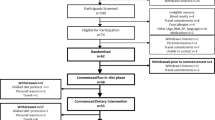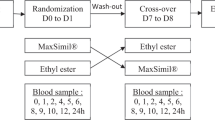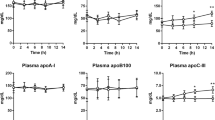Abstract
Objectives: To determine relative effects of diets high in synthetic sources of myristic (14:0), palmitic (16:0) or stearic (18:0) acid on concentrations and metabolism of serum lipoproteins.
Design: Eighteen healthy women participated in a three-way cross-over study for five week periods separated by seven week washout periods, diets were assigned in random order.
Subjects: Premenopausal women, not on medication, were from three races (Caucasian, African-American, Asian) and four apolipoprotein E phenotype groups (3/3, 3/2, 4/3, and 4/2).
Intervention: During the first week the subjects consumed a baseline diet providing 11 energy (en)% saturated fat, 10 en% polyunsaturated fat and 14 en% monounsaturated fat. Followed by test diets with 19 en% saturated fat (including 14 en% test saturated fatty acid), 3 en% polyunsaturated fat, and 14 en% monounsaturated fat for four weeks. Synthetic fats (trimyristin, tripalmitin, and tristearin) were used in blends with natural fats and oils.
Results: Mean concentrations of serum total, esterified and LDL cholesterol were significantly lower after 18:0 than after 16:0 (n=16–18, P<0.01 for treatment effect). Myristic acid (14:0) had an intermediate effect. Receptor-mediated degradation of 125I-LDL in mononuclear cells obtained from the subjects was lower after 16:0 than after 14:0 and 18:0 (n=16–18, P=0.05 for treatment effect). Differences in the digestibilities of the fats were not a major factor in the results. Strong cholesterolemic responses to the 16:0 diet were partly explained by apoE phenotype.
Conclusions: As noted previously, stearic acid was neutral compared to 14:0 and 16:0. In contrast to studies involving natural fats, 14:0, fed as a synthetic triglyceride, was less cholesterolemic than 16:0 in a majority of subjects. ApoE phenotype influenced the cholesterolemic response particularly when diets high in 16:0 were eaten.
Sponsorship: Funded by United States Department of Agriculture Grant 93-37200-8978.
This is a preview of subscription content, access via your institution
Access options
Subscribe to this journal
Receive 12 print issues and online access
$259.00 per year
only $21.58 per issue
Buy this article
- Purchase on Springer Link
- Instant access to full article PDF
Prices may be subject to local taxes which are calculated during checkout
Similar content being viewed by others
Author information
Authors and Affiliations
Corresponding author
Rights and permissions
About this article
Cite this article
Snook, J., Park, S., Williams, G. et al. Effect of synthetic triglycerides of myristic, palmitic, and stearic acid on serum lipoprotein metabolism. Eur J Clin Nutr 53, 597–605 (1999). https://doi.org/10.1038/sj.ejcn.1600815
Received:
Revised:
Accepted:
Published:
Issue Date:
DOI: https://doi.org/10.1038/sj.ejcn.1600815
Keywords
This article is cited by
-
Low sat-structured fats enriched in α-linolenic acid: physicochemical properties and crystallization characteristics
Journal of Food Science and Technology (2017)
-
Stearic acid is well absorbed from short- and long-acyl-chain triacylglycerol in an acute test meal
European Journal of Clinical Nutrition (2007)
-
Effect of Interesterification of Palmitic Acid‐rich Triacylglycerol on Postprandial Lipid and Factor VII Response
Lipids (2007)
-
Dietary stearic acid and risk of cardiovascular disease: Intake, sources, digestion, and absorption
Lipids (2005)
-
Influence of dietary saturated fatty acids on the regulation of plasma cholesterol concentration
Lipids (2005)



